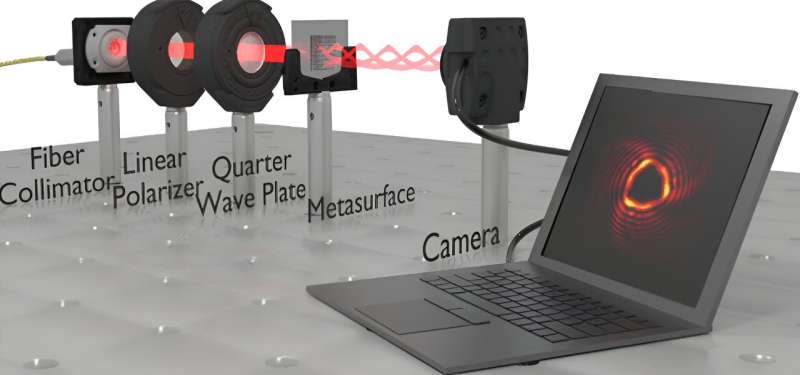This article has been reviewed according to Science X's editorial process and policies. Editors have highlighted the following attributes while ensuring the content's credibility:
fact-checked
peer-reviewed publication
proofread
New tractor beam technology could one day minimize biopsy trauma

Researchers at TMOS, the ARC Center of Excellence for Transformative Meta-Optical Systems, have taken an important first step in the development of metasurface-enabled tractor beams—rays of light that can pull particles toward it, a concept that fictional tractor beams featured in science fiction are based on.
In research published in ACS Photonics today, the University of Melbourne team describes their solenoid beam that is generated using a silicon metasurface. Previous solenoid beams have been created by bulky special light modulators (SLMs). However, the size and weight of these systems prevent the beams being used in handheld devices.
The metasurface is a layer of nanopatterned silicon only about 1/2000 of a millimeter thick. The team hopes that one day it could be used to take biopsies in a non-invasive manner, unlike current methods such as forceps that cause trauma to the surrounding tissues.
Beams of light tend to exert a pushing force, moving particles away from the light source. Solenoid beams have been proven to draw particles toward the light source. Consider the way a drill works, pulling wood shavings up the drill bit. Solenoid beams work similarly.
This particular solenoid beam has several benefits over previously generated solenoid beams in that the required conditions of the input beam are more flexible than with previous beams, it doesn't require an SLM, and the size, weight and power requirements are significantly less than previous systems.
The metasurface was created by mapping the phase hologram of the desired beam. This was used to create a pattern. The metasurface was then fabricated from silicon using electron beam lithography and reactive ion etching.
When the input beam, in this case a Gaussian beam, filters through the metasurface, most of it (approximately 76%) is converted into a solenoid beam and bends away from the unconverted beam, allowing the researchers to work with it without obstruction. They were able to characterize the beam at a distance of 21 centimeters.
Lead researcher Maryam Setareh says, "The compact size and high efficiency of this device could lead to innovative applications in the future. The ability to pull particles using a metasurface might have the potential to impact the field of biopsy by potentially reducing pain through less invasive methods."
Setareh says, "We are excited to investigate the performance of our device in particle manipulation, which could offer valuable insights."
Chief Investigator Ken Crozier says, "The next stage of this research will be to experimentally demonstrate the beam's ability to pull particles, and we'll be excited to share those results when they're available."
Crozier says "This work opens new possibilities for using light to exert forces on tiny objects"
More information: Maryam Setareh et al, High Efficiency Triple-Helix Solenoid Beam Generated by Dielectric Metasurface, ACS Photonics (2024). DOI: 10.1021/acsphotonics.4c00874
Journal information: ACS Photonics
Provided by ARC Centre of Excellence for Transformative Meta-Optical Systems





















